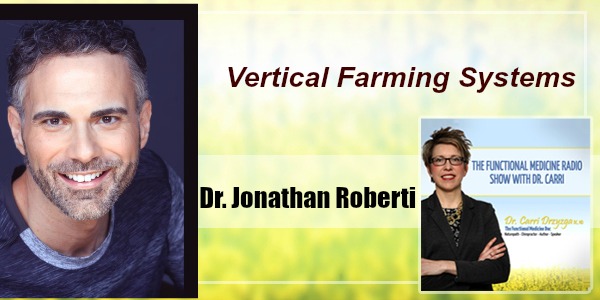Podcast: Play in new window | Download
Subscribe: Apple Podcasts | Android | RSS
In this episode of The Functional Medicine Radio Show, Dr. Carri’s special guest Dr. Jonathan Roberti talks about vertical farming systems and how to become modern farmers.
Dr. Jonathan Roberti is a clinical practitioner, researcher, author, celebrated speaker, and consultant. His clinical and practice interests include integrative medicine, plant-based nutrition, psychoneuroimmunology and inspiring conscious living.
Dr. Jonathan advocates a ‘Back-to-Basics’ mentality that prioritizes ‘self-care’ and focuses on prevention by creating simple and sustainable strategies that eliminate barriers to health and happiness. With education and support, the conversation shifts towards empowering individuals and communities that inspire transformations and lasting change. Central to this transformation is the quality of nutrition & simple lifestyle changes that solidify healthier habits.
Main Questions Asked:
- What is vertical farming all about and how can we do it?
- What science is involved in vertical farming systems?
- What kind of work goes into vertical farming systems?
- What about during the winter or days that are overcast?
- Are there plants that don’t do well in a tower garden?
- Where can we get more information about vertical farming systems?
Key Points Made by Dr. Jonathan:
- Vertical farming is a method of farming using aeroponics within a two and half square footprint. It doesn’t use soil and can grow food in all seasons of the year.
- By 2050, the human population will be over 10 billion.
- Our current food production capabilities and processes are not sufficient to handle that growth.
- The average distance your food currently travels is over 900 miles.
- Growing your own food through vertical farming systems allows you to control the level of pesticides, chemicals, and radiation you are exposed to.
- Vertical farming systems allow you to grow food in virtually any space and any climate.
- The best foods are the ones that don’t have a label or a television commercial.
- Vertical farming systems produce food that is considerably more nutritious than soil based crops.
- If you want to get healthier, you need to take ownership of your food.
- The technology and structures involved in vertical farming are based on NASA advances; it creates food that is at its nutritional best.
- Calculate how much you are spending on fresh vegetables.
- The shorter the length of time between harvesting and consumption, the more nutritious it is.
- The weekly maintenance of a tower garden is less than 15 minutes. You have to check the water, harvesting the plants, and adding the nutrients. The tools you use are a pair of scissors and a pH meter.
- Vertical farming systems are mobile, plants can be grown indoors when it is colder than 40 degrees with a light kit and moved outdoors when it’s warmer.
- The only two types of plants you can’t really grow in a tower garden are trees and root vegetables.
- For the average family of four, the tower garden will pay for itself within six months. After the first year, the average operating cost is $1.25 a month.
- The system takes care of itself in many ways; you can leave for days at a time and have the system set up so that it continues to grow.
- Self care is the new health care.
- Growing your own food is a great way to teach kids about food and the virtues of hard work and self-reliance.
Resources Mentioned:
Book – Reclaim Your Energy and Feel Normal Again
Thank you for listening! If you enjoyed this podcast, please subscribe and leave a 5 star rating and review on iTunes!




